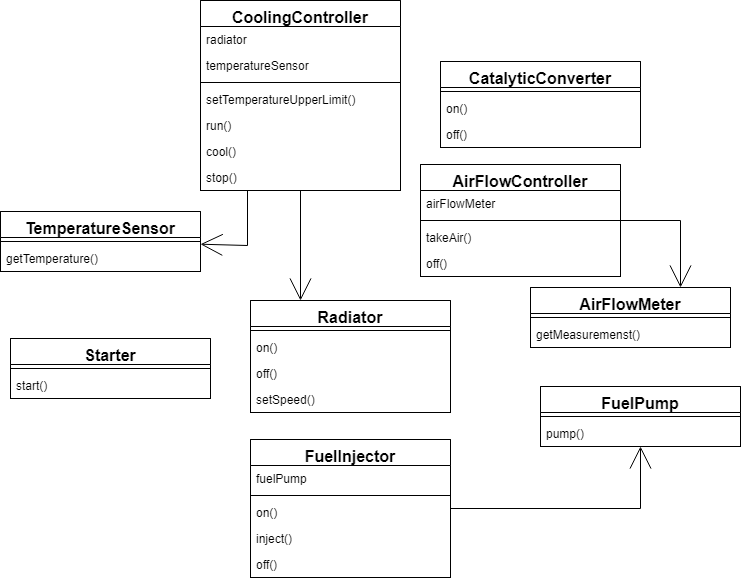概述
简单地说,门面Facade将一个复杂的子系统封装在一个简单的接口后面。它隐藏了许多复杂性,并使子系统易于使用。
此外,如果我们需要直接使用复杂的子系统,仍然可以,并没有必须一直使用门面接口。
除了更简单的界面之外,使用这种设计模式还有一个好处,它将客户端实现与复杂的子系统解耦。多亏了这一点,我们可以对现有的子系统进行更改,而不会影响客户端。
示例
比方说我们想发动一辆汽车。下图表示遗留系统,它允许我们这样做:

正如所看到的,流程可能非常复杂才能正确启动发动机:
airFlowController.takeAir()
fuelInjector.on()
fuelInjector.inject()
starter.start()
coolingController.setTemperatureUpperLimit(DEFAULT_COOLING_TEMP)
coolingController.run()
catalyticConverter.on()同样,停止发动机也需要相当多的步骤:
fuelInjector.off()
catalyticConverter.off()
coolingController.cool(MAX_ALLOWED_TEMP)
coolingController.stop()
airFlowController.off()门面正是这里所需要的,我们将在两个方法中隐藏所有的复杂性:startEngine()和stopEngine():
public class CarEngineFacade {
private static int DEFAULT_COOLING_TEMP = 90;
private static int MAX_ALLOWED_TEMP = 50;
private FuelInjector fuelInjector = new FuelInjector();
private AirFlowController airFlowController = new AirFlowController();
private Starter starter = new Starter();
private CoolingController coolingController = new CoolingController();
private CatalyticConverter catalyticConverter = new CatalyticConverter();
public void startEngine() {
fuelInjector.on();
airFlowController.takeAir();
fuelInjector.on();
fuelInjector.inject();
starter.start();
coolingController.setTemperatureUpperLimit(DEFAULT_COOLING_TEMP);
coolingController.run();
catalyticConverter.on();
}
public void stopEngine() {
fuelInjector.off();
catalyticConverter.off();
coolingController.cool(MAX_ALLOWED_TEMP);
coolingController.stop();
airFlowController.off();
}现在,要启动和停止汽车,我们只需要2行代码,而不是13行:
facade.startEngine();
// ...
facade.stopEngine();缺点
Facade模式只添加了额外的抽象层。有时,在简单的场景中可能会过度使用该模式,这将导致冗余的实现。
结论
门面Facade模式很常用,比如Slf4j日志门面,只需要简单使用日志框架的接口调用,而无需理会背后的日志框架实现是使用logback还是log4j2。































